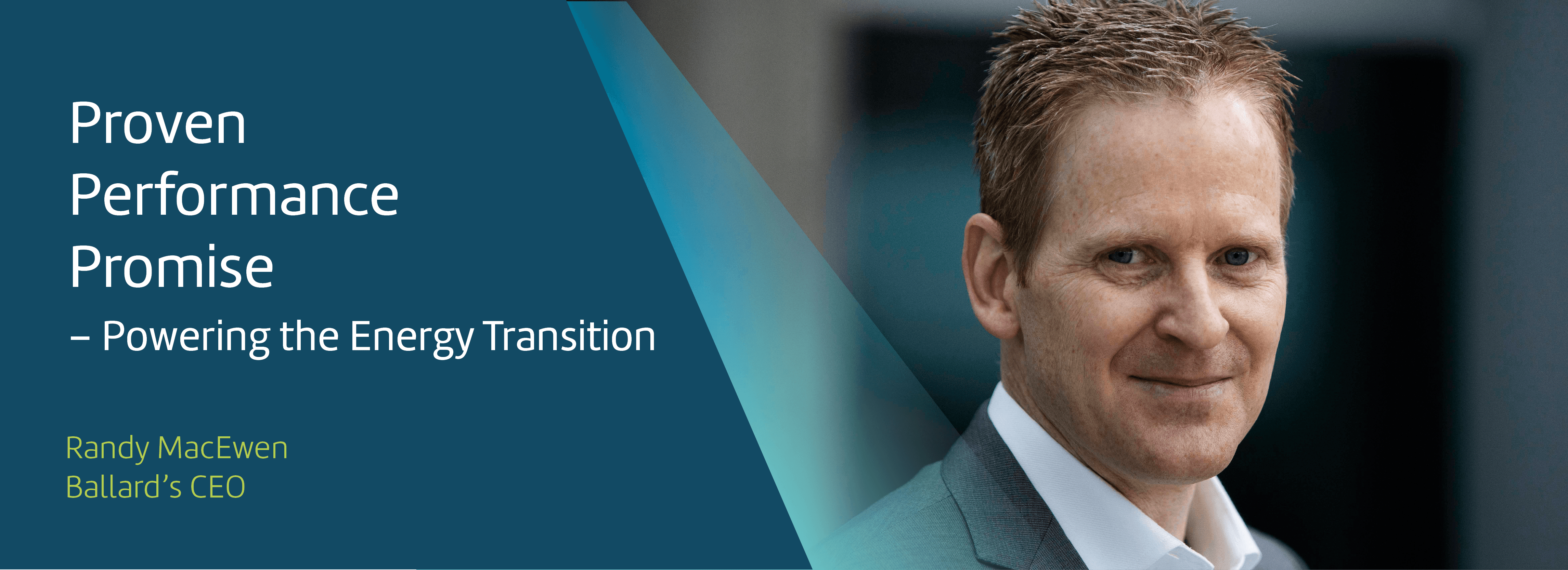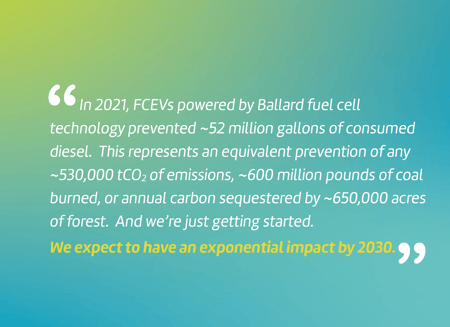2024 – Challenges, Silver Linings and the Road Ahead for the Hydrogen and Fuel Cell Industry
Randy MacEwen reviews a challenging year where Ballard Power Systems stayed focused, secured record orders, and progressed next-gen fuel cell...
We discuss the energy transition, hydrogen and fuel cell industry with Randy MacEwen, Ballard’s CEO, and why Ballard is in a strong position to win.
 As 2023 takes shape, we sit down with Randy MacEwen, Ballard Power Systems' CEO, to discuss his views on the energy transition, the hydrogen and fuel cell industry, and why Ballard is in a strong position to win.
As 2023 takes shape, we sit down with Randy MacEwen, Ballard Power Systems' CEO, to discuss his views on the energy transition, the hydrogen and fuel cell industry, and why Ballard is in a strong position to win.
There can be little doubt the energy transition is underway. Sustainability and energy security are prominent on global political agendas; both are dependent on the energy transition. Increasingly, stakeholders – governments, corporates, institutions, industry associations, investors, and consumers – are adopting or advocating for goals and plans to reach net zero by 2050. Over 130 countries, representing approximately 90% of global GDP, have adopted net zero targets.
In many countries, renewables – typically solar and wind – are now the lowest cost sources of new power generation and are making up an increasing portion of grid mixes. This is very exciting.
There is also a growing recognition that for society to achieve net zero, hydrogen must play an important role in the energy transition, including in certain hard-to-abate industries and applications. At this time, 40 countries, representing over 80% of global GDP, have announced hydrogen strategies or roadmaps. At Ballard, we expect hydrogen to provide approximately 20% of the world’s energy by 2050. So, while a comprehensive energy transition will take time, the direction is clear.
We need to recognize that what we are talking about is disrupting mature markets that have entrenched technologies, infrastructure, and customer operating models.
For example, at Ballard we target the medium- and heavy-duty mobility applications (bus, truck rail, and marine) where the value proposition for hydrogen fuel cells are expressed most strongly (long range, fast refueling time, no material compromise on payload) and where the barriers to refueling infrastructure are lowest (i.e. where you have vehicles that typically return to base for centralized refueling and don’t need a distributed refueling infrastructure).
For fuel cells to win in these markets, we have been working to validate technology readiness, while also providing an attractive comparative customer economic value proposition based on total cost of ownership.
This is hard. Very hard. Sure, we are working hard to displace dirty diesel engines with clean fuel cells. But we also need to have attractive customer economics. This means displacing diesel engines that have proven performance and reduced costs at scale for decades. This means getting customers to trial disruptive technology in early adopter volumes that hasn’t reached scaled commercialization.
As an industry, we are not – yet - at volume production, scaled deployments, and a robust supply chain and ecosystem, including low-cost, low-carbon hydrogen supply. So, decarbonizing medium- and heavy-duty motive is not a trivial exercise, particularly in the context of an energy transition that depends on disrupting a trusted 100-year-old mobility infrastructure. The disruption will not occur in a straight line.
Fortunately, we can learn from solar, wind, and batteries. With strong policy support for early adopters, we can start to scale volumes and reduce costs. We know this model works to accelerate the pace of adoption. We also know that society has consistently proven that when it comes to innovation and disruption, it’s always slow – until it’s not.
My expectation is that the energy transition, including the adoption of low carbon hydrogen and fuel cell vehicles in heavy mobility, will happen at scale much faster than most industry reports are forecasting. In 2030, with the benefit of an obvious tipping point, many will be looking back to 2023 with revisionist history saying, “of course this was going to happen”. Notably, many of the so-called experts significantly underestimated the adoption curve for wind, solar, and battery electric cars. The hydrogen energy transition is now in sight, and we are all fired up at Ballard.
Many industry observers will likely flag favorable policy shifts in the United States and Europe as the two most important developments over the past year.
In the United States, the Inflation Reduction Act is a true game-changer for hydrogen and fuel cells in the US market. Significant keystrokes have already been dedicated to explaining the IRA. For the hydrogen industry, the clear highlight is the $3 per kilogram production tax credit for renewable hydrogen. This tax credit will enable the scaling of green hydrogen production, providing fuel cell applications (such as buses, trucks, trains, marine vessels, forklifts, and stationary power generators) with access to a firm supply of low-cost, low-carbon fuel.
And, in Europe, the European Commission quickly responded to the hardships and global energy market disruption caused by Russia’s invasion of Ukraine. The European Commission recognized the double urgency to transform Europe’s energy system by ending the EU’s dependence on Russian fossil fuels and tackling the climate crisis. This recognition resulted in the introduction of REPowerEU, which plans to scale-up and speed-up the roll-out of renewables and renewable hydrogen production. And on February 13, 2023, the European Commission released the long-awaited “delegated act” defining criteria hydrogen must fulfill to qualify as “renewable”. We expect this EU-wide definition of “renewable hydrogen” will now unlock final investment decisions for large-scale electrolyser projects to move from project development to real hydrogen production over the next few years.
To be clear, these policy shifts are powerful enablers. There is also another exciting dynamic that will accelerate market adoption. We would also draw attention to the surging end-customer (user) interest and engagement we are seeing for the adoption of fuel cell electric vehicles across the medium- and heavy-duty mobility applications. 
Yes, what we have seen over the past two years is that customers understand the world is changing. They are not questioning whether they need to embrace zero-emissions energy. They know they must. The conversation has pivoted to how to do it, and who they should partner with.
Our customers are faced with important decisions that will have long-term implications for their companies. They are looking for a trusted, knowledgeable partner with a clear purpose and a track record with real-world experience. They are looking for long-term partners to stand behind them and invest in future scaling. In short, they want a partner who is Here for life™.
At Ballard, our promise is that “we are here for you” – for our customers as well as the-users of the product or service they provide. Ballard’s proven technology, the performance of our fuel cell products, and customer care support network are here to ensure success through this transition to a cleaner, greener, and more secure future.
Our Ballard commitment is built on three pillars – Proven, Performance, and Promise.
 In addition, we currently have eight fuel cell ship projects in development, including the world’s first passenger ferry powered by liquid hydrogen. We have seven hydrogen train projects with leading OEMs. And we have deployed fuel cells in over 8 MW of stationary power projects.
In addition, we currently have eight fuel cell ship projects in development, including the world’s first passenger ferry powered by liquid hydrogen. We have seven hydrogen train projects with leading OEMs. And we have deployed fuel cells in over 8 MW of stationary power projects.
Importantly, we have successfully grown our experience from involvement in the fuel cell industry’s first concepts and pilot projects to real-world expertise in commercializing and optimizing fuel cells to volume applications.
We have proven that fuel cells safely and reliably work, that fuel cells last (e.g., over 30,000 hours lifetime in London buses) and that fuel cells are suitable for heavy-duty mobility applications, such as transit buses, regional haul trucks, a 300t mining truck, regional commuter rail, freight locomotives, and high-speed passenger ferries.
Delivering fuel cell power to some of the hardest working fleets in the world, there can be no compromise on performance or payload.
We are proud of our product range and have been successful in creating market leading products – the FCmove™ family of motive solutions being a prime example. Collaborating with customers and technology partners, we have expanded the eighth generation FCmove™ product platform from 45kW to 120kW to address the most demanding heavy-duty transport applications, and successfully introduced 200kW solutions for rail, marine, and stationary applications.
Ballard’s FCwave™ marine product was the first fuel cell module to receive Type Approval from DNV for installation on board a marine vessel.
In short, our strategy is to refine and drive synergies from our core technology across multiple markets to gain volume advantages, while technology innovation and partnerships drive our continuous efforts to reduce product cost. Ballard’s leadership position is a critical factor in driving economies of scale and our focus on Total Cost of Ownership (TCO) is essential for creating a value proposition that can also make our customers successful.
In parallel, it is critically important that we keep the speed of market adoption in our line of sight and proactively address friction points by offering energy system and/or powertrain integration to help our customers launch new fuel cell vehicle platforms in the most efficient and cost-effective way.
The powertrain integration expertise of Ballard Motive Solutions, coupled with our collaboration with battery pack manufacturer Forsee Power, allow us to effectively integrate fuel cell-battery hybrid architectures to improve and optimize the performance and efficiency of hydrogen powertrain.
I see this as the point where Ballard’s on-road experience, in-house systems and powertrain integration capabilities, and partnerships converge. This convergence is all designed to deliver more value to customers.
Underpinning our pillars of commitments is the promise of unrivalled customer support – when and where you need it most. We work hard to understand the challenges our customers face and to anticipate their needs. Over the years we have developed a support model that has proven to be highly effective in supporting products deployed globally.
With Ballard’s Customer Care program, customers have one point of contact for a 360-degree support and service response, from pre-sale technical support through integration, training, field service support, on-going maintenance, and fleet monitoring.
Ensuring that our customers can expect sustainable power from a sustainable company, Ballard’s “Mission Carbon Zero” reflects our plan to become carbon neutral by 2030. We undertake an annual inventory of corporate emissions, and life cycle assessments of our fuel cell stacks and heavy-duty power modules. These calculations allow us to effectively evaluate and track our carbon footprint and help guide our long-term strategies for removing and offsetting our emissions.
The common denominator across our three pillars of commitment is that we’re dedicated to investing in our technology, products, future scaling, and customer experience to bring fuel cell product lifecycle cost to parity with diesel and accelerate the transition to a zero-emission world. This is our customer promise.

The energy transition is underway. The move to hydrogen is underway. Ballard is positioned to win. Put these together, and the future at Ballard is very bright. I have never been more convinced of this than I am today.
Randy
To view Ballard's 2023 corporate brochure, click below
Randy MacEwen reviews a challenging year where Ballard Power Systems stayed focused, secured record orders, and progressed next-gen fuel cell...
Read the inspiring story behind the Ballard Power Systems brand renewal, including our updated logo and new tagline, Here for Life™.
As Ballard enters its next phase of commercialization, Tim Sasseen, market development director, looks at Ballard's growth trajectory in the region.
